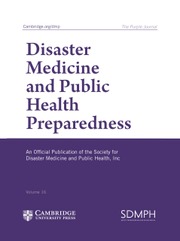No CrossRef data available.
Article contents
Evaluation of the Opinions of Volunteers Involved in Disaster on the Use of Social Media
Published online by Cambridge University Press: 24 March 2025
Abstract
The aim was to deeply examine the opinions of volunteers who took part in the Kahramanmaraş-centered earthquakes that occurred in Türkiye on February 6, 2023, regarding the use of social media during the disaster period.
The study was designed as qualitative research. Because it was planned to examine the participant experiences in depth, the phenomenological design was employed in the study. Study data were collected from individuals who had earthquake experience through a semi-structured interview form between May 2023 and July 2023.
In line with the data obtained, 2 themes were created: “social media content and communication analysis” and “social media impact analysis and results.” It was found that for information seeking, information sharing, or interaction during disasters, Twitter (X), Instagram, and WhatsApp were the most preferred social media platforms, respectively. Participants mentioned that posts related to disaster during times of disasters have an impact on their emotions. It was determined that the proper use and correct management of social media tools in times of earthquakes affect coordination and relief efforts.
It was concluded that the type of content shared during earthquake times affects both disaster victims and other individuals of the society positively or negatively.
- Type
- Original Research
- Information
- Copyright
- © The Author(s), 2025. Published by Cambridge University Press on behalf of Society for Disaster Medicine and Public Health, Inc.


